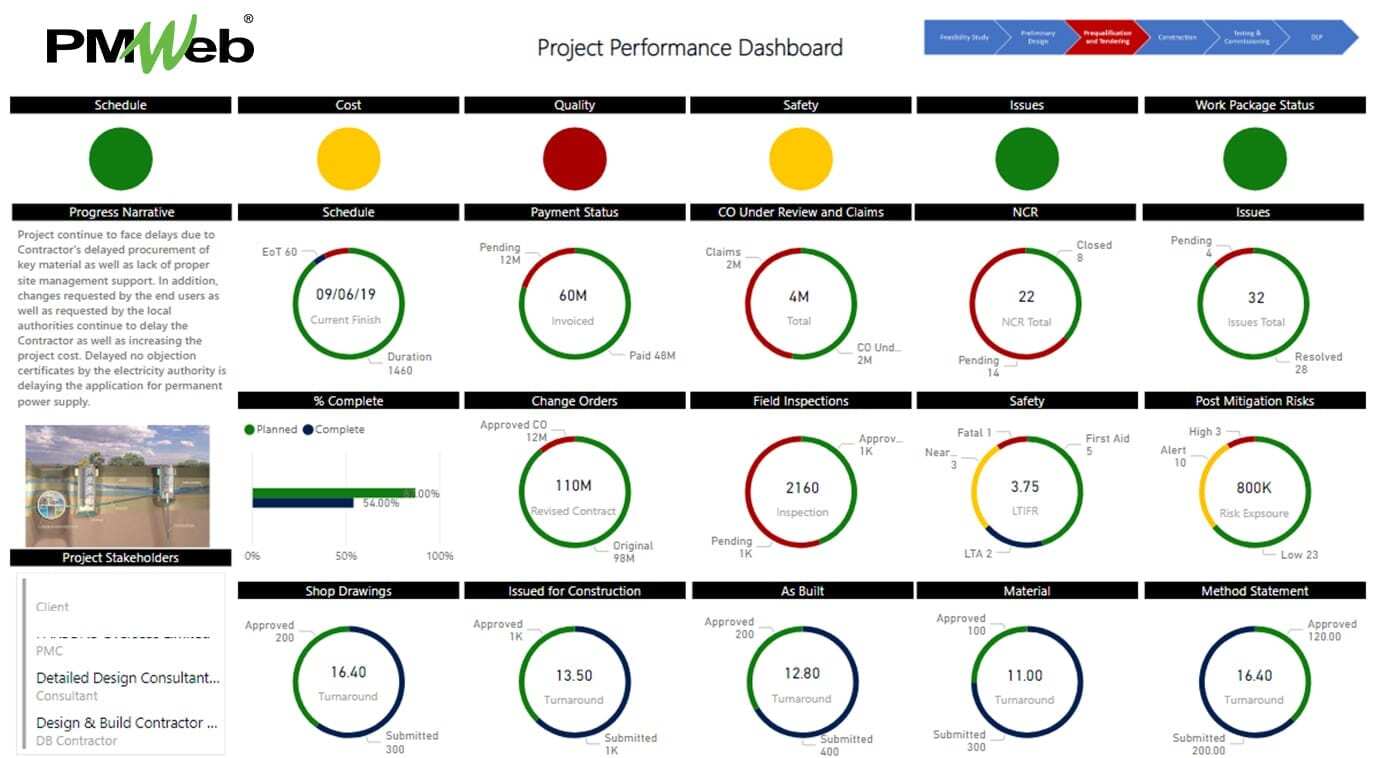One would rarely find a construction project that does not have individuals who are assigned the responsibility of performing the tasks for monitoring, controlling, and reporting the construction projects’ performance. Those individuals are known as the project control team where it usually consists of a project control manager, project control engineer, planning and scheduling engineer, document controllers, and sometimes a cost engineer. The project control team will use different applications to establish what is known as the Integrated Management Information System (IMIS), Project Control System (PCS), or Project Management Information System (PMIS) needed to monitor, control, and report the construction project’s performance.
The Integrated Management Information System (IMIS) should be designed to provide the project team with trustworthy information to support their decision-making process as well as report a single version of the truth on the construction projects’ performance status. Therefore, the IMIS should provide as a minimum the project management team with real-time information as it relates to the following project management processes:
- Performance dashboard that shows the status of the project’s key performance indicators as it relates to scope, schedule, cost, risk, quality and health, safety and environment (HSE).
- Status of the updated project schedule including milestone status, two-week lookahead, critical path report and delayed activities reports.
- Status of actual resources deployed on the project compared to what was planned.
- Status of the project’s approved budget baseline, approved budget spending and budget adjustments.
- Status of all awarded contracts including potential, pending and approved change orders.
- Status of all progress invoices for each awarded contract, non-contract invoices and actual payments made against approved invoices.
- Earned Value Management report to integrate planned budget spending and actual expenditures.
- List of all potential and implemented cost savings associated with the conducted value engineering studies.
- Register of all claim notices and disputes.
- Register of extension of time (EOT) requests and their status.
- Status of insurance and bond documents.
- Current risk register and risk heatmap.
- Updated companies’ directory listing all approved and blacklisted consultants, contractors, subcontractors and vendors.
- Log of Request for Information (RFI) with their status.
- Log of all pending meeting business items along with the responsible individual for action.
- Log of all material and equipment submittals
- Log of all shop drawings, as-built drawings and BIM models.
- Log of all material and equipment to be procured and installed on the project.
- Log of all incoming and outgoing communication by type including correspondence, site work instructions, confirmation of verbal instructions, transmittals among others.
- Pending Issues Register
- Register of all Safety Incidents
- Register of all Work Permits issued on the project
- Register of all Gate Passes
- Register of No-Objection Certificates from permitting authorities
- Register of all Work Inspection Requests (WIR) grouped by relevant specification section.
- Register of all Non-Compliance Requests (NCR)
- Register of all testing and commission inspections
- Narrative report to document the project control team analysis of the current project performance and recommended actions to bring or maintain the project on track.
This requires the PCS team to carefully design those dashboards and reports in a format that tells the story on how the project is performing as well as provide the project team with the insight for making better and faster informed decisions. In addition, the growing requirement for social distancing because of the COVID-19 pandemic, project team members should be able to access those dashboards and reports anywhere, anytime using any device. Therefore, the IMIS must be web-enabled with secured access to avoid unauthorized individuals from accessing critical project information.
The greatest challenge would be how to design a single page dashboard that can tell a single version of the truth of the project’s current performance status in a format that all executive stakeholders would concur on. The dashboard will include the needed key performance indicators (KPIs) to monitor, evaluate and report the project’s schedule, budget, cost, quality, HSE, issues among others.
The project’s picture which is usually part of the project performance dashboard can be hyperlinked to the IP address of the construction camera installed on the project site. The construction cameras are usually time lapse cameras that come ready with specific features and functions needed for construction projects. The hyperlink can be also created for pre-recorded videos completed using drones or any other type of video camera.
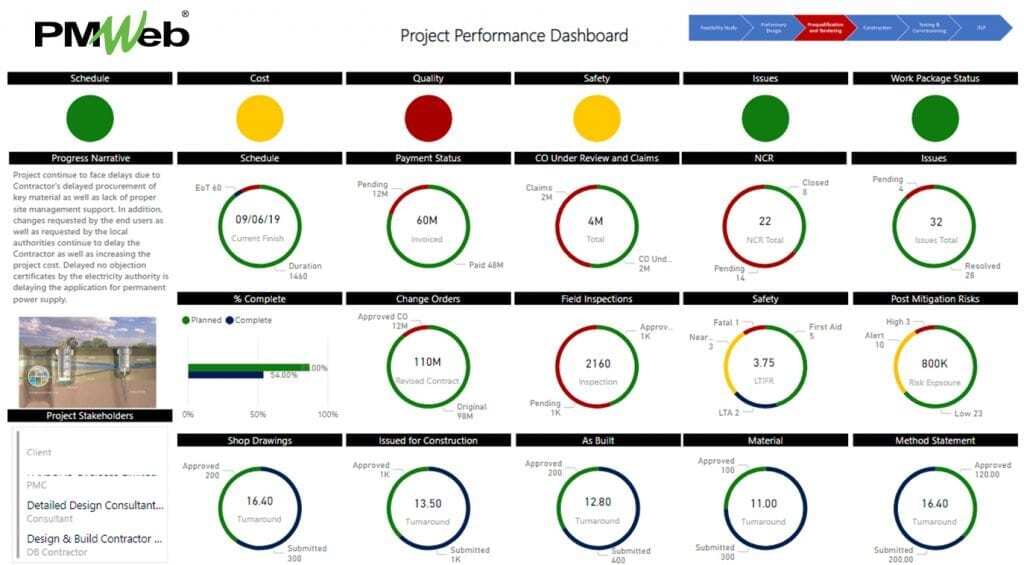
Similarly, the reports generated by the IMIS should be self-explanatory for the reader and should include the information needed to take sound actions on what could be impacting the project’s performance. The reports should include the option to enable the reader to filter the reported data on predefined fields such as status, date, responsibility, location, WBS level among others to better focus what matters most for the reader.
It is highly recommended that the IMIS reports include, in addition to the common tabular details, visuals to summarize the content the reported information. Those visuals should be aligned with the visuals used in the project’s performance dashboard. For example, if the project’s performance dashboard included a donut chart to show the status of Request For Information (RFI), then the RFI register report should include this visual as well as other visuals to better understand, monitor and evaluate the current status of the RFI process. This is also important to enable the project performance dashboard reader to drill-down to the report that details the information summarized in the visual. In other words, when the dashboard reader clicks on the RFI visual, he/she will be automatically direct to the RFI statue report. The same approach will be applicable to the many other reports that the IMIS will generate.
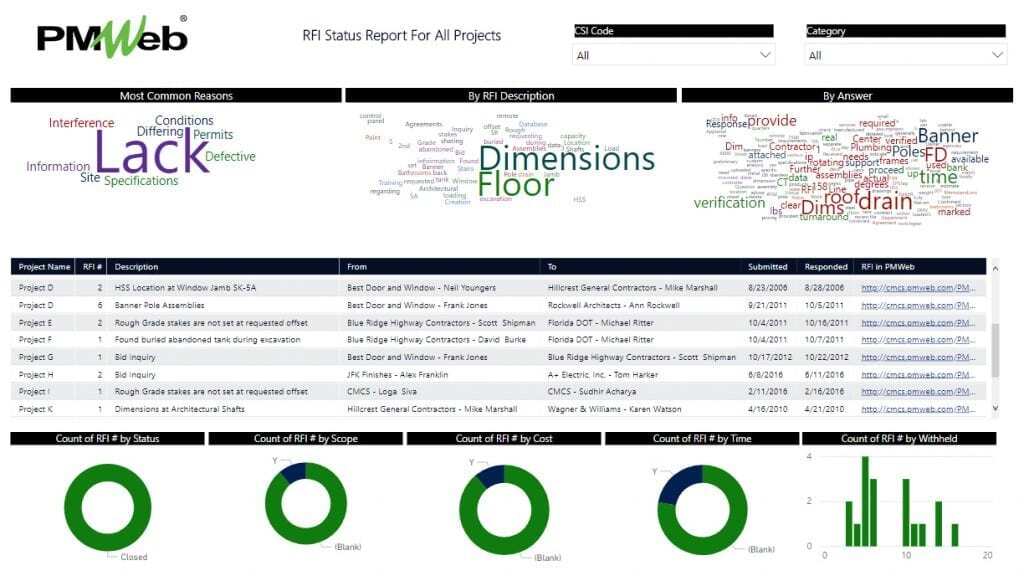
The growing trend of using Building Information Modeling (BIM) in construction projects, allows to further enhance the quality of the IMIS reports. For example, a report can be created to display the project’s BIM model, either in IFC or Revit file format, along with the issued RFIs. Each RFI needs to be associated with the BIM model asset that is associated with to enable visualizing this information in the report. This will make the RFI report as an interactive report where selecting a single or a group of RFIs will immediately show the BIM assets associated with those RFIs. The same could be done for Work Inspection Requests, Non-Compliance Reports among others.
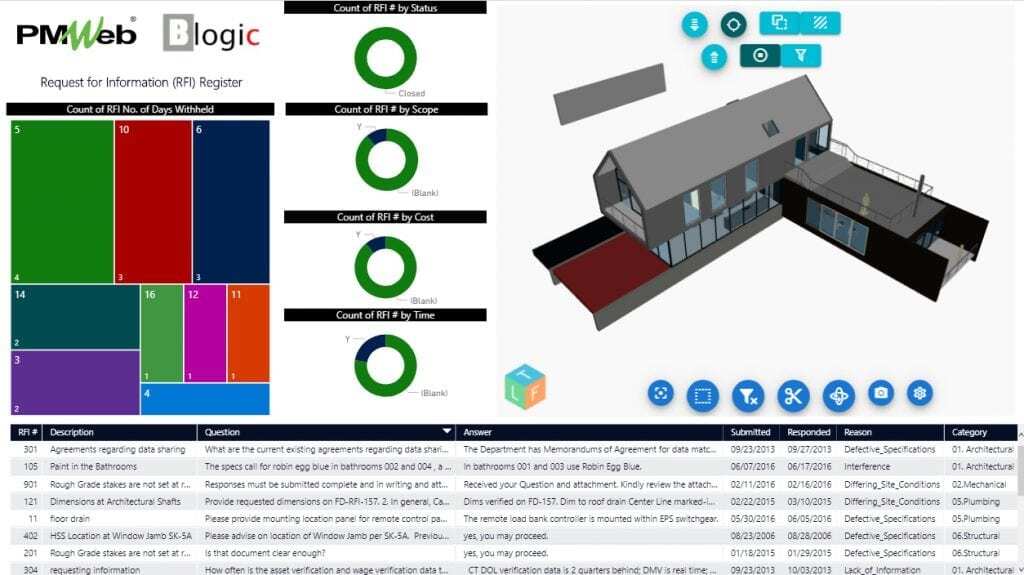
Of course, this leads to the most critical aspect of all, the quality of the data being reported on. The information that the IMIS will report on will be based on the data captured in the project schedule, whether it was Primavera or MS Project, as well as the data captured in the many other project management processes such as RFI, meeting minutes, budget, contracts, progress invoices, change orders, permits, submittals among many others. Although using MS Excel as the platform to capture and store this information is possible, at what deficiency does it perform this task when it comes to assuring timely capturing of data, accuracy of captured data, completeness of captured data, accountability for captured data, secured access of captured data among many others.
Using a Project Management Information System (PMIS) like PMWeb, will eliminate those deficiencies as well as provide the many other benefits of having a single data source for all project management processes across the complete projects’ portfolio that the organization has.
PMWeb comes ready with most of the project management processes needed on an engineering construction project. Those include Request for Information, Meeting Minutes, Transmittals, Safety Incident, Submittals, Punch List among others. Access to those forms will be given to the authorized project team members for which they will be restricted to edit data included in selected fields within each form. Most of those ready to use communication forms have all the possible fields needed to execute those processes including some unique fields the project schedule activity that could be impacted by the communication as well as the WBS level that this communication relates to. Of course, there is no limit to the additional user defined fields that can be added to those forms which could be text, numeric, currency, date, list of values and Boolean.
In addition to those ready to use forms, PMWeb visual custom form builder allows the creation of unlimited new forms to address all other formal communication requirements on projects. Those custom forms will include all the needed fields and tables with the option to define the access rights for each field and table within the form.
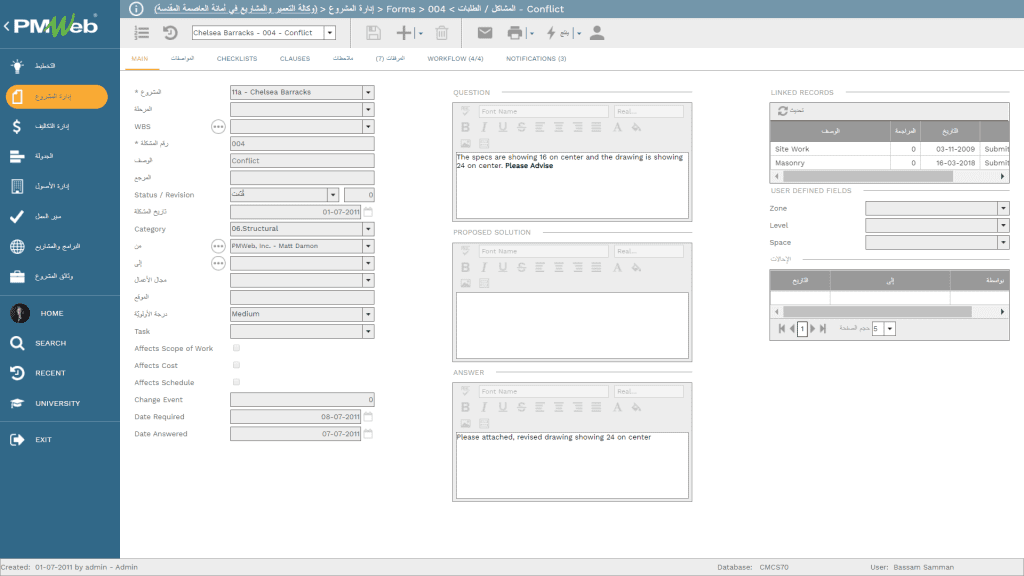
For each form, whether default PMWeb form or custom created form, all supportive documents can be attached to the selected form. Those documents can be either stored in the PMWeb document management repository or directly uploaded to the record if needed. In addition, links to other relevant project communications and imported MS Outlook emails which will be stored in PMWeb can be also made. Further, hyperlinks to the other locations where documents could have been stored can also be done as long as the document integration has been done.
All those project management processes can be assigned a workflow to formalize the submit, review and approval process as detailed in the responsibility assignment matrix (RAM) and project management plan (PMP). The workflow will detail the sequence of tasks to be performed by the different project team members as well as the actions can be taken by each and to whom the communication should be returned if it is rejected. Further, the workflow could include conditions to map the approval authority levels. Finally, and to enforce formal communication requirements, PMWeb integration with DocuSign Digital Signature can be used to require selected workflow steps, or all, to be signed digitally using DocuSign.
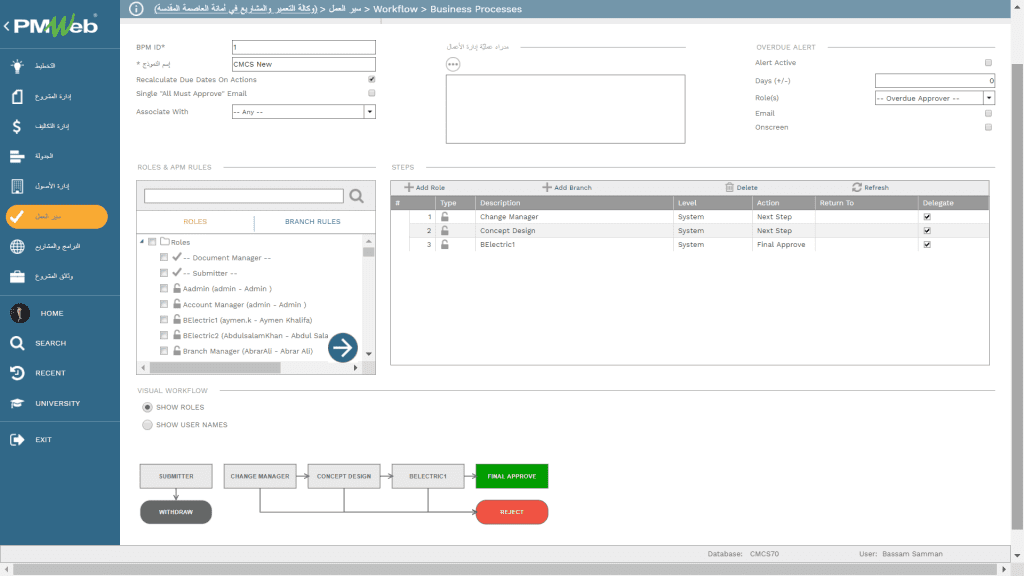
So, the question that needs to be answered, are you ahead, within or behind the curve when it comes to monitoring, controlling and reporting construction projects performance? and how does this affect the occurrence likelihood of the high-cost risk of project failure.

